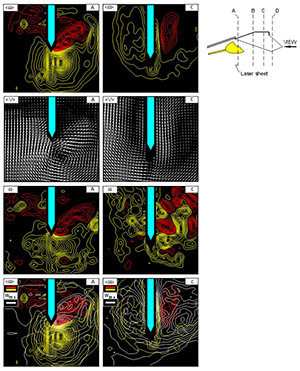You are here
Home ›Vortex Breakdown- Tail Interaction
Vortex interaction with tail of an aircraft. Interaction of a broken-down vortex with a generic tail is indicated in the schematic. The centerline of the vortex is nominally aligned with the tail, and the planes of observation are A through D. Views corresponding to planes A and C are shown in the left and right columns. The initial stage of interaction is indicated by the time-averaged vorticity contours <ω> at A, in conjunction with the averaged velocity field <V>. These images show that the incident vortex induces separation from the tip of the tail, which leads to formation of a large-scale concentration of positive (red) vorticity, in addition to the negative (yellow) vortex. The instantaneous pattern of vorticity ω indicates a close correspondence to the pattern of averaged vorticity <ω>. An overlay of averaged vorticity <ω> and root-mean-square velocity fluctuation wrms shows that the peak levels of ωrms occur at the interface between the positive and negative clusters of vorticity.
Further along the tail, corresponding to image plane C, the shedding of the positive (red) vortex is complete. The pattern of instantaneous vorticity ω shows substantial deviations from the averaged pattern <ω> in reality, the well-defined cluster of positive vorticity is actually made up of smaller-scale concentrations. The peak values of ωrms occur at the interface between the positive and negative regions of vorticity on the right (outboard) side of the tail, and are nearly coincident with the peak value of vorticity ω on the left (inboard) side.
The interaction of a broken-down vortex with a simulated tail involves two major concentrations of vorticity: a primary (incident) vortex; and a secondary (counter) vortex. The origin of the secondary vortex is recognized and defined for the first time using patterns of vorticity and velocity. Furthermore, the streamwise variation of the primary-secondary vortex system is interpreted via patterns of root-mean-square velocity fluctuation and Reynolds stress. Peak values can occur at, or in the vicinity of, the interface between the primary and secondary vortices during the initial stage of development of the vortex system. Further downstream, additional peaks of velocity fluctuations and Reynolds stresses can be identified; they are associated with distortion of the primary vortex about the tail.

